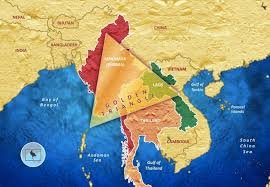By Madara Dias, MHR Program, University of Manitoba
Date: May 30, 2025
Overview
As the international community grapples with Myanmar’s political crisis and human rights violations, an equally insidious threat continues to undermine efforts for peace in the region as narco-terrorism. This growing menace is deeply embedded in Myanmar’s complex internal conflicts and thrives along its porous borders with Bangladesh, Thailand, Laos, India, and China. Often overshadowed by high-level diplomatic discussions and humanitarian concerns, the role of narcotics trafficking in sustaining insurgent violence and destabilizing regional security deserves urgent attention. Myanmar today is not only a country in political turmoil but also a central node in a multi-billion-dollar drug economy that sustains conflict, corruption, and public health crises across Southeast and South Asia.
Understanding Narco-Terrorism in Myanmar
At the heart of Myanmar’s protracted internal strife lies a deeply entrenched and lucrative narcotics industry. The drug trade in this context is more than a criminal enterprise and it is consider as a key driver and financier of armed conflict. Ethnic armed organizations (EAOs), such as the Arakan Army (AA), the United Wa State Army (UWSA), and the Kachin Independence Army (KIA), rely heavily on revenues generated through the production, taxation, and transportation of illicit substances like opium and methamphetamine. These groups may not directly operate drug laboratories, but they facilitate safe passage and levy transit taxes, embedding the trade within the broader ecosystem of conflict.
The Arakan Army, for instance, controls and protects a crucial trafficking corridor stretching from Shan State through Rakhine and into Bangladesh. The proceeds from this trafficking are not peripheral, but they form the financial bedrock of insurgent operations. Dr. Halal Mahudin, co-founder and research director at the Conflict and Resilience Research Institute Canada, notes that this convergence of conflict and crime has far-reaching consequences, undermining not just internal peace efforts but regional stability. Narcotics originating in Myanmar increasingly cross into neighboring states, fueling corruption, health crises, and security threats. In 2023 alone, Thailand seized over 25 tons of methamphetamine, while India’s Northeast emerged as both a trafficking conduit and a consumption hotspot. Malaysia has become a key regional distribution hub, and even China, with its stringent border controls, struggles to contain the flow. This transnational narco-terror network necessitates a coordinated regional approach that treats the drug trade as a core obstacle to peace, not just a criminal issue.
The Golden Triangle: A Geopolitical Drug Nexus
The infamous and the largest Golden Triangle where Myanmar, Laos, and Thailand converge remains one of the world’s most prolific centers of illicit drug production. Shan State, in particular, with its rugged terrain and limited state presence, serves as the center of both opium and synthetic drug production. Narcotics produced here move swiftly into neighboring countries, including India, Bangladesh, China, and Vietnam. By 2023, the size of Myanmar’s drug economy had reached an estimated $10 billion, surpassing formal economic sectors in several regions, according to Dr. Mahudin. This shadow economy remains largely unchecked, often outpacing both the capacity and political will of state actors to dismantle it.
Opium cultivation surged by 36% in 2023, reaching 1,080 metric tons, reaffirming Myanmar’s position as the world’s second-largest opium producer after Afghanistan (UNODC, 2024). Meanwhile, methamphetamine production has exploded. In 2022, over 1 billion tablets were seized across Southeast Asia, with around 70% believed to have originated from clandestine labs in Shan State. The synthetic drug Yaba tablets which combining methamphetamine and caffeine that prevalent and continues to flood regional markets.
Trafficking Routes & Cross-Border Impacts
The westward flow of methamphetamine from Shan State through Rakhine and into Bangladesh has created a deeply entrenched trafficking corridor. Key entry points include Teknaf and Ukhiya in Cox’s Bazar, where traffickers distribute the drugs to urban hubs such as Chattogram and Dhaka. These cities now serve as both consumption centers and redistribution points. In 2023 alone, Bangladeshi law enforcement seized more than 45 million Yaba tablets, with the majority traced back to Myanmar (Border Guard Bangladesh & Department of Narcotics Control, 2024). The drug crisis has escalated to a public health emergency, with over one million Bangladeshis which include youth that believed to be addicted to Yaba. This places enormous strain on public health and law enforcement agencies already stretched thin.
One of the most disturbing developments in this crisis is the exploitation of the Rohingya refugee community. Living in dire poverty and limbo in camps near Cox’s Bazar and Teknaf, many are vulnerable to recruitment by drug traffickers. Primarily, young boys and increasingly children are coerced or lured into becoming drug mules. For many families living in extreme conditions, the promise of quick income outweighs concerns over legality or safety. This tragic dynamic not only exacerbates the humanitarian crisis but also deepens regional security risks. Dr. Mahudin emphasizes that drug trafficking in these areas is frequently linked to arms smuggling, turning refugee camps into assets for criminal syndicates and insurgent groups alike.
Regional Spillover and ASEAN’s Silent Crisis
Myanmar’s drug crisis is no longer a national problem, but it is a regional emergency. Countries such as Thailand, Bangladesh, India, and Vietnam are experiencing the brunt of the spillover, in the form of drug addiction, trafficking, corruption, and organized crime. India’s Northeast is increasingly vulnerable, while Vietnam has reported growing meth-related arrests and usage. Thailand’s 25-ton meth haul in 2023 highlights the industrial scale of trafficking from Myanmar.
Despite these alarming trends, the regional response, primarily ASEAN member states remains fragmented and muted. Political sensitivities regarding Myanmar’s military regime, economic entanglements (particularly with China), and ASEAN’s non-interference doctrine have all contributed to this inertia. According to the International Crisis Group and the Global Initiative Against Transnational Organized Crime (GI-TOC), this silence has enabled trafficking networks to thrive with minimal resistance. Myanmar’s role as a primary drug source has become an open secret which is privately acknowledged, but publicly ignored in diplomatic circles.
Historical Roots and Present Complicity
The narcotics economy in Myanmar has deep historical roots. During the colonial period, British authorities tolerated and taxed opium cultivation, embedding the drug trade into Burma’s political economy. During the Cold War, the drug trade became further entrenched as a geopolitical tool. Declassified reports and investigative research suggest that the CIA, in its support of anti-communist militias like remnants of the Kuomintang in northern Burma, turned a blind eye on heroin trafficking to finance their operations (McCoy, The Politics of Heroin, 2003).
Recently, this complicity extends to state actors. The Tatmadaw, along with certain local officials and political elites, are widely suspected of benefiting from the drug trade. Reports indicate that military elements oversee protection rackets and manage key trafficking routes. This “hot money” not only funds counterinsurgency operations but also enriches loyalists and entrenches a system of impunity. Without institutional reform and accountability, any attempts at peace or development are likely to fail. As Dr. Mahudin argues, the drug economy has hollowed out governance, compromised judicial independence, and sabotaged transitional justice.
Transparency, Cooperation, and Courage: A Path Forward
Tackling Myanmar’s drug-fueled crisis requires more than reactive crackdowns. A durable solution hinges on political will, regional cooperation, and the courage to acknowledge uncomfortable truths. Dr. Mahudin outlines three pillars essential for progress: transparency, cooperation, and courage.
First, transparency is critical. The drug trade in Myanmar has persisted under a veil of silence which due in part to diplomatic caution and the complicity of powerful actors. The first step is honest public discourse within Myanmar, across ASEAN, and globally. This must be followed by robust data sharing and coordinated seizure records, cross-border intelligence collaboration, and public mapping of trafficking flows are necessary to break the current cycle of impunity.
Second, the region must move toward genuine cooperation. Existing responses are fragmented and siloed, with each country prioritizing its own enforcement or rehabilitation measures. There is an urgent need for a multilateral drug control framework that incorporates joint border operations, cross-border data systems, alternative livelihoods for opium growers, and comprehensive rehabilitation services. A Canada-facilitated initiative, involving Bangladesh, India, China, Thailand, and Myanmar, could serve as a neutral platform for regional dialogue and action drawing on Canada’s history of post-conflict peacebuilding.
Lastly, courage is needed to reframe the drug crisis as not merely a criminal issue, but a broader peace and justice challenge. Marginalized populations such as, Rohingya refugees and ethnic minorities, must be seen not just as threats or liabilities, but as communities in need of investment, inclusion, and hope. Sustainable peacebuilding must include education, livelihood support, and justice mechanisms that address the root causes of conflict.
From Crisis to Compact
Solving Southeast Asia’s drug crisis requires more than interdiction and it requires imagination, integrity, and collaboration. The narco-terrorism emanating from Myanmar is a regional threat that fuels violence, undermines development, and erodes public trust in institutions. A comprehensive peace strategy must treat drug control as central to regional stability, not as a side issue. It is time for policymakers, civil society, and international allies to unite around a shared vision. Further, which may prioritize transparency, fosters cooperation, and musters the courage to confront entrenched impunity. The cost of inaction is too high, not just for Myanmar, but for the future of peace in all of South and Southeast Asia.



